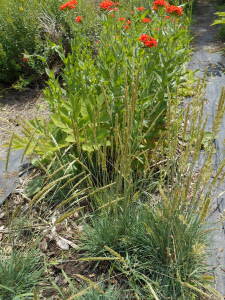Description
ARCHIVED
Note: This is a plant not currently for sale. This is an archive page preserved for informational use.
Erect spike-like panicles June thru August, poke above a neat mound of erect, blue grass blades.
Erect spike-like panicles June thru August
ARCHIVED
Note: This is a plant not currently for sale. This is an archive page preserved for informational use.
Erect spike-like panicles June thru August, poke above a neat mound of erect, blue grass blades.
ARCHIVED
Note: This is a plant not currently for sale. This is an archive page preserved for informational use.
Large, nodding flower heads with recurved petals white, glowing pinkish in August, fragrant.
Size: 3-4’ x 12”
Care: Sun to part shade in moist, acidic soil
Lilium was named for the Greek word for smooth, polished referring to its leaves. This species introduced to Europe by Carl Peter von Thunberg around 1777. Von Thunberg (1743-1828), student of Linnaeus at Uppsala University in Sweden. He made three trips to the Cape of Good Hope 1772-1775 where he collected about 1000 new species, Java and Ceylon (Sri Lanka) 1777 and 15 months in Japan (1775-1777) where he befriended local doctors who gave him hundreds of plants new to Western horticulture. He succeeded Linnaeus as professor of medicine and botany at Uppsala. Knighted by Swedish King Gustav. Grown at America’s 1st botanic garden, Elgin Botanic Garden 1811. L.H. Bailey (1935) highly recommended this lily as “(o)ne of the most beautiful and satisfactory of all lilies, robust, permanent (and) easily grown…”
ARCHIVED
Note: This is a plant not currently for sale. This is an archive page preserved for informational use.
Rosette of thick silver-grey leaves with an inch-long terminal tip of each spine and offshoots, knowns as “pups” emerge near the base, even of young plants. Flowers only once & takes +10 years. In Z 5-6 plant in spring to get established.
Size: 18” x 18-28”
Care: sun in well-drained soil. We grow this in Z 5A on the south-facing side of a mound of well-drained soil, with a few large rocks nearby and gravel mulch.
Native: mountains of Arizona and New Mexico.
First Americans in the SW traded baked leaves and buds hundreds of years ago. Roasted stalks,baked buds & water mixed & fermented make pulque, further distilled to make mescal or tequila.
ARCHIVED
Note: This is a plant not currently for sale. This is an archive page preserved for informational use.
Dainty (appearing but actually tough) pink daisies with yellow centers from summer through autumn, very long blooming. Wonderful for rock gardens, groundcover or front of border.
Size: 12” x 12” spreading
Care: full sun in well-drained soil. Slow to emerge in spring.
Native: Eastern No. America
Coreopsis is Greek meaning “buglike” referring to the seeds looking like little black bugs. Thomas Nuttall 1st collected this flower in 1815 about 20 miles NW of Savannah along the river. He described its native habitat: “in open grassy swamps from New Jersey to Georgia…” William Robinson, father of the mixed perennial border called this “a neat and pretty plant.” In 1913 Sanders wrote that it “make(s) a brilliant display of color (when) grown in masses in sunny borders.”
ARCHIVED
Note: This is a plant not currently for sale. This is an archive page preserved for informational use.
Cheerful, small white daisies flower all summer and autumn.
Size: 18-24” x 12”
Care: Full sun moist well-drained soil
Native: Europe and Caucasus
Common name “Feverfew” speaks for itself, referring to the plant’s medicinal qualities. The species’ name parthenium comes from Plutarch who claimed that the plant saved the life of a construction worker who fell from the Parthenon. Feverfew was prescribed to remedy coughs, indigestion, congestion, melancholy, hysteria, vertigo, freckles, opium overdoses and for “them that are giddie in the head.” Parkinson. A favorite early cottage garden flower. Pressed specimen in Emily Dickinson’s herbarium.

